OK, so here’s the deal. I know I’ve been dragging out the Hybrid Oak thing for a while. But honest, I only have one more post to go about Hybrid Oaks (well until I find the next one anyway…) But yesterday I had the coolest lunch break ever- so cool, I just have to blog about it. Here’s what happened:
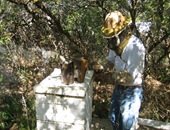 About a month ago, we (Awesome Wife, Trifecta and I) went to a party. It was at a friend of my wife’s place down near the mouth of Little Cottonwood Canyon. They have a couple of acres, a beautiful yard, a small orchard, some pasture (they board horses), tons of beautiful, interesting shrubs and flowers, and a number of beehives. It was a great party, the kind where everyone- adults, spouses, kids- has a good time.
About a month ago, we (Awesome Wife, Trifecta and I) went to a party. It was at a friend of my wife’s place down near the mouth of Little Cottonwood Canyon. They have a couple of acres, a beautiful yard, a small orchard, some pasture (they board horses), tons of beautiful, interesting shrubs and flowers, and a number of beehives. It was a great party, the kind where everyone- adults, spouses, kids- has a good time.
This Part Feels Like A Tangent But Isn’t
That last point is significant. Nowadays, most parties I go to fall into one of three categories:
1) Grown-up party we get invited to by one of my wife’s friends. My wife has a great time, I have a ”play-date” with the other husbands, who may or not be interesting, have anything in common with me, or be people I’d spend more than 30 seconds talking with in the real world.
2) Grown-up party we get invited to by one of my friends. I have a great time, but the incessant, single-themed talk of biking, skiing, camping and hiking trips quickly grows old for my non-outdoor-head wife.
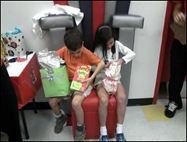 3) Kid’s parties. Our kids are constantly attending or hosting birthday parties. The good birthday parties are the “Drive-Bys.” You drive by, drop off your kid, pick him/her/them up 3 hours later. The bad kind are the “Parents-Attend-Too” party, where the adults are supposed to stay and “celebrate” as well, which invariably means making conversation with some of the oddest people (your kids’ friends’ parents) you’re ever likely to come across.
3) Kid’s parties. Our kids are constantly attending or hosting birthday parties. The good birthday parties are the “Drive-Bys.” You drive by, drop off your kid, pick him/her/them up 3 hours later. The bad kind are the “Parents-Attend-Too” party, where the adults are supposed to stay and “celebrate” as well, which invariably means making conversation with some of the oddest people (your kids’ friends’ parents) you’re ever likely to come across.
But this party was none of those 3. The hostess is a friend of my wife, but she was also the Twins’ pre-school teacher, and so many of their friends were there. And to round it out, her husband, a bright friendly guy I met for the first time that night, is a beekeeper.
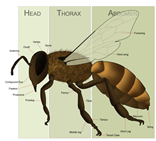 For years I’ve been fascinated by bees. I’ve read probably ½ a dozen bee-related books, and there’s so much about them I find interesting: their communal societies, their venom, their role as pollinators, their bizarre genetic model, and of course, honey. I’ve always wanted to try my hand at beekeeping, but it’s sort of been like hunting for me; I’ve always been curious to try it, but no one in my family ever did it, and I’m not close to anyone who does it regularly today.
For years I’ve been fascinated by bees. I’ve read probably ½ a dozen bee-related books, and there’s so much about them I find interesting: their communal societies, their venom, their role as pollinators, their bizarre genetic model, and of course, honey. I’ve always wanted to try my hand at beekeeping, but it’s sort of been like hunting for me; I’ve always been curious to try it, but no one in my family ever did it, and I’m not close to anyone who does it regularly today.
The host-husband- let’s call him “Spence”- was eager to talk bees with a fellow enthusiast, and we spent a good part of the evening touring his hives, looking at gear and talking about honey harvests. At the end of the night he invited me to join him to help harvest the honey in a week or so.
One delay led to another- logistics, travel, weather issues- and we missed several tentatively planned harvest dates. Finally yesterday morning I got an email; Spence has Wednesdays off, and was planning to harvest that day. A quick phone call, a moved meeting, and I was back at Spence’s place donning a bee veil and heavy gloves, ready to spend my lunch “hour” as an assistant beekeeper.
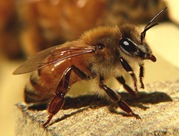 We’ve touched on bees a couple of times earlier this year, including Orchard Mason Bees (genus = Osmia) and Bumblebees (genus = Bombus.) Honeybees belong to the genus Apis, which includes 7 species, all native to the Old World. The European Honeybee- the species we’re most familiar with- is Apis mellifera. A. mellifera is further divided into more than 2 dozen subspecies, 2 of which are most popular with North American beekeepers, both for their gentle nature and their productivity: The Italian Honeybee, A. mellifera linguistica, (pic right) and the Carniolan Honeybee, A. mellifera carnica.
We’ve touched on bees a couple of times earlier this year, including Orchard Mason Bees (genus = Osmia) and Bumblebees (genus = Bombus.) Honeybees belong to the genus Apis, which includes 7 species, all native to the Old World. The European Honeybee- the species we’re most familiar with- is Apis mellifera. A. mellifera is further divided into more than 2 dozen subspecies, 2 of which are most popular with North American beekeepers, both for their gentle nature and their productivity: The Italian Honeybee, A. mellifera linguistica, (pic right) and the Carniolan Honeybee, A. mellifera carnica.
Honey Basics
Non-commercial beekeepers, like “Spence”, generally harvest once a year. The idea is that the bees spend all spring and summer collecting nectar which they convert into honey and deposit into wax cells that they build in their hives, and then laying and caring for eggs in those cells. But the bees overproduce to the extent that the beekeeper is able to take the majority of honey from a healthy hive toward the end of the season.
 People have been stealing- and later harvesting- honey for thousands of years, but the single most important invention in beekeeping was the Langstroth Hive (pictured right, invented by Lorenzo Langstroth) in 1860. The Langstroth Hive consists of a box with a series of removable frames, each of which is filled up with wax and honey over the course of the season. The design allows the beekeeper to easily remove the frames, harvest the honey, and then replace the frames, thereby getting the honey without destroying the hives. There had been earlier frame-style hives, but Langstroth’s breakthrough was to figure out the correct spacing between the frames- 3/8”. Less than that, and the bees can’t move freely between the frames. Greater than 3/8”, and the bees fill the spaces with a cement-like substance called propolis that inhibits removal of the frames.
People have been stealing- and later harvesting- honey for thousands of years, but the single most important invention in beekeeping was the Langstroth Hive (pictured right, invented by Lorenzo Langstroth) in 1860. The Langstroth Hive consists of a box with a series of removable frames, each of which is filled up with wax and honey over the course of the season. The design allows the beekeeper to easily remove the frames, harvest the honey, and then replace the frames, thereby getting the honey without destroying the hives. There had been earlier frame-style hives, but Langstroth’s breakthrough was to figure out the correct spacing between the frames- 3/8”. Less than that, and the bees can’t move freely between the frames. Greater than 3/8”, and the bees fill the spaces with a cement-like substance called propolis that inhibits removal of the frames.
So, harvesting honey consists of 5 steps:
1- Blow smoke on the bees to calm them down.
 2- Open the top of the hive and remove the frames, brushing or smoking off cling-on bees.
2- Open the top of the hive and remove the frames, brushing or smoking off cling-on bees.
3- Take the frames someplace away from the hive (like Spence’s garage/barn.)
 4- Un-cap the honeycomb cells. Each cell is capped by wax. You uncap them by slicing off the top layer with a heated knife (pic right.)
4- Un-cap the honeycomb cells. Each cell is capped by wax. You uncap them by slicing off the top layer with a heated knife (pic right.)
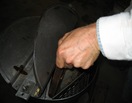 5- Put the frames- 4 at a time- into a “Spinner”, (pic left) basically a hand-cranked spinning barrel that uses centrifugal force to get the honey out of the (now-uncapped) cells. The honey drains out from a spigot at the bottom of the barrel.
5- Put the frames- 4 at a time- into a “Spinner”, (pic left) basically a hand-cranked spinning barrel that uses centrifugal force to get the honey out of the (now-uncapped) cells. The honey drains out from a spigot at the bottom of the barrel.
I’m leaving out a lot, but that’s the general idea. Here’s an action video of the most exciting part- removing the frames, in the midst of a swarm of agitated bees.
Tangent: No, I never got stung. I was actually surprised how smoothly the whole deal went. I actually have a whole slew of great bee-sting, and near bee-sting stories, including getting stung on the lower lip while mtn biking on 3 separate occasions, and a near-miss with an angry Africanized swarm a few years back in the Mojave, that I thought about trying to work into a tangent in this post, but I get the feeling this one’s going to be pretty long as it is…
When we finished I headed back to the office, with a cup full of probably the best honey I’ve ever tasted.
So What’s The Deal With Bees Anyway?
The fact that bees can sting, make honey, and have a single queen makes them interesting enough, but the really amazingly weird thing about bees is their genetics.
Way back when, around a billion years ago, after complex living things- or Eukaryotes- had split into plants and animals, but before there were fish or dragonflies or anything like that, animals took 2 different evolutionary structural paths. One group started to evolve an internal support framework- initially cartilage, later bone, and became the Chordates. That group eventually led to sharks, lizards, turtles, birds, moose, cats, dogs and us.  The other group started to evolve a support structure on the outside, which later became chitin, and that group eventually led to spiders, lobsters, butterflies, woodlice, shrimp, crickets and bees. We haven’t shared a common ancestor with bees since that split, and yet, over the intervening billion years, our separate evolutionary paths have tackled so many of the same problems- vision, thermoregulation, nervous systems, smell, communication. The solutions we’ve ended up with to these problems are in each case wildly different, but probably the strangest area of difference is in genetics and reproduction.
The other group started to evolve a support structure on the outside, which later became chitin, and that group eventually led to spiders, lobsters, butterflies, woodlice, shrimp, crickets and bees. We haven’t shared a common ancestor with bees since that split, and yet, over the intervening billion years, our separate evolutionary paths have tackled so many of the same problems- vision, thermoregulation, nervous systems, smell, communication. The solutions we’ve ended up with to these problems are in each case wildly different, but probably the strangest area of difference is in genetics and reproduction.
For most of the creatures we’ve talked about in this blog, both animals and plants, the normal genetic baseline has been diploidy. That is, half a set of chromosomes from each parent. That’s how it works for us and moose and turtles and birds, and although plants have made all kinds of innovations, like polyploidy and ring meiosis, it’s the basic model for them as well.
 But bees, as well as wasps and ants- all members of the insect order Hymenoptera- have taken a different genetic path. Over 100 million years ago they forsook full diploidy, and the path they’ve taken since has led them to become one of the most successful groups of animals in the history of life, with tens of thousands of species all over the planet.
But bees, as well as wasps and ants- all members of the insect order Hymenoptera- have taken a different genetic path. Over 100 million years ago they forsook full diploidy, and the path they’ve taken since has led them to become one of the most successful groups of animals in the history of life, with tens of thousands of species all over the planet.
Side Note: The original Hymenopterans are thought to have been wasps, which are generally predatory, and often parasitic. At some point, some wasps switched over from a primarily carnivorous to a primarily pollen & nectar-based diet, and these wasps presumably evolved into bees.
Hymenoptera are Haplo-Diploid, meaning that some members of the species- specifically females- are fully diploid, while the males have only half the number of chromosomes as the females. In my family, this would be as though Awesome Wife and Twin B had 46 chromosomes, while I, the Bird Whisperer and Twin A only had 23 chromosomes.
But the analogy breaks down there, because in Hymenoptera, males have no fathers- each is created from an unfertilized egg. Fertilized eggs always develop into females- either fertile females (queens) or sterile females (workers.)
With bees, the model gets even weirder, because queen bees mate with just one drone (male) during their mating flight.
Adults-Only-Tangent: The reason for this is both simple and grotesque. When bees mate, the male’s genitalia is ripped from his body, and remains lodged in the female’s genital opening. This of course leads to the drone’s death. Another tidbit, so long as we’ve broached the topic of genitalia: Bees can only mate in flight, in mid-air, because wind is required to expose their genitalia.
The queen returns to her hive with a cargo of sperm from her single mating flight, and that sperm will be used to produce fertilized eggs (workers and queens) for the rest of her life.
But it gets even weirder, because each one of those millions of sperm she brought back with her is exactly the same. This makes sense when you think about it: a sperm cell is haploid (half the number of chromosomes.) But a drone has only half the number of chromosomes to begin with, so each one of his millions of sperm produced carries exactly the same (all of his) genes.
So What?
Why does this matter? Here’s why: In a “normal” diploid family like mine, siblings are on average 50%-related. Twin A and Twin B have about ½ of their genes in common (they’re fraternal, not identical.) That’s because they each got a random sampling of ½ of my genes and ½ of Awesome Wife’s genes, so they probably got about half of the same total stuff out of the deal.
But with sister worker-bees, it’s different; they got roughly half the same stuff from their mother, but they got exactly the same stuff from their father (because all his sperm are identical), so on average, they’re 75%-related. Bees, like people are only 50%-related to their parents and their offspring (think about it, it makes sense) so that means that worker bees are more closely related to their sisters than they would be to their own offspring (if they had them.)
Step Back
 In the big picture, living things exist to do one thing: make copies of their genes. This isn’t because they want to or should do so or are told to; it’s simply because things that makes copies of themselves tend to be more common and persist much more so than things that don’t. In the human world, it’s simple. I have kids, my friend Paul doesn’t. 50 years from now, my tree-geek genes will still be around; his rainbow-spirit-believing-genes won’t. My coworker Tom has 7 kids. 50 years from now there’ll be a lot more of his good-coworker genes around than my tree-geek genes.
In the big picture, living things exist to do one thing: make copies of their genes. This isn’t because they want to or should do so or are told to; it’s simply because things that makes copies of themselves tend to be more common and persist much more so than things that don’t. In the human world, it’s simple. I have kids, my friend Paul doesn’t. 50 years from now, my tree-geek genes will still be around; his rainbow-spirit-believing-genes won’t. My coworker Tom has 7 kids. 50 years from now there’ll be a lot more of his good-coworker genes around than my tree-geek genes.
But if you’re more closely related to your sisters than you are to your own children, then the most productive thing you can do to propagate your own genes is… help your mother make more daughters. And now, living in a hive and busting your butt to support your queen/mother while forsaking reproduction yourself doesn’t look so pointless. Again, it’s not that bees want to make sisters, but rather that those that do make more sisters become much more common over time than bees that don’t.
Back Home
The honey was a great hit with the family, and a step forward in my ongoing, long-term, low-intensity lobbying campaign to introduce a hive to our yard. Bird Whisperer and Twin B are now firmly in my camp; Twin A and Awesome Wife are still holdouts. But it’s a while till next Spring, and I’ve made a living in sales for 20 years. Time is on my side.

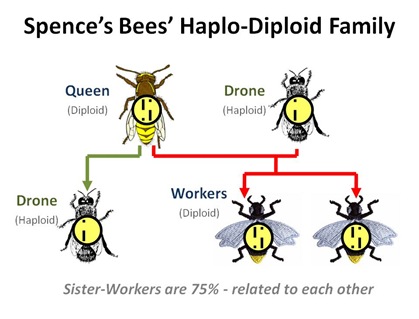
2 comments:
So, what about Twin A & Awesome Wife? Did you get them convinced & go for it? Beekeeping is an incredibly rewarding hobby, as I think you alreay know. If you haven't started already, there's always next spring....
BestBeekeeping- not yet! But I am hopeful for this coming year. I now have 2 beekeeping friends encouraging me. Thanks for asking!
Post a Comment